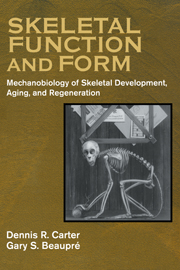Book contents
- Frontmatter
- Contents
- Preface
- Chapter 1 Form and Function
- Chapter 2 Skeletal Tissue Histomorphology and Mechanics
- Chapter 3 Cartilage Differentiation and Growth
- Chapter 4 Perichondral and Periosteal Ossification
- Chapter 5 Endochondral Growth and Ossification
- Chapter 6 Cancellous Bone
- Chapter 7 Skeletal Tissue Regeneration
- Chapter 8 Articular Cartilage Development and Destruction
- Chapter 9 Mechanobiology in Skeletal Evolution
- Chapter 10 The Physical Nature of Living Things
- Appendix A Material Characteristics
- Appendix B Structural Characteristics
- Appendix C Failure Characteristics
- Index
Chapter 9 - Mechanobiology in Skeletal Evolution
Published online by Cambridge University Press: 11 January 2010
- Frontmatter
- Contents
- Preface
- Chapter 1 Form and Function
- Chapter 2 Skeletal Tissue Histomorphology and Mechanics
- Chapter 3 Cartilage Differentiation and Growth
- Chapter 4 Perichondral and Periosteal Ossification
- Chapter 5 Endochondral Growth and Ossification
- Chapter 6 Cancellous Bone
- Chapter 7 Skeletal Tissue Regeneration
- Chapter 8 Articular Cartilage Development and Destruction
- Chapter 9 Mechanobiology in Skeletal Evolution
- Chapter 10 The Physical Nature of Living Things
- Appendix A Material Characteristics
- Appendix B Structural Characteristics
- Appendix C Failure Characteristics
- Index
Summary
In the preceding chapters we have described how mechanical loading histories regulate skeletal biology, with an emphasis on extant terrestrial mammals. The cellular and molecular mechanisms responsible for this control have not been addressed and for the most part remain unknown. These mechanisms, and thus the associated mechanobiological rules, have a genetic basis and are accordingly subject to basic evolutionary selection processes. This chapter addresses evolutionary questions associated with skeletal mechanobiology and the morphology of bones in different taxa. We seek, as did Roux, Wolff, and Thompson, a mechanistic and not a teleological explanation of the morphological differences among bones.
Genotypic variations in vertebrate cartilage and bone both permit and constrain the range of skeletal features that can appear in the skeleton (Moss and Moss-Salentijn, 1983). To understand the possible phylogenetic basis for differences in skeletal tissue response to mechanical stimuli, it is important first to understand the evolution of bone developmental processes that determine morphology. A broad view of the evolution of skeletal characteristics in different taxa was presented in Chapter 1, and the reader may wish to review that material before proceeding (Figure 1.6).
Consider two adult animals of different taxa but similar size and anatomical construction. Assume that the morphology of a particular bone, like a femur, is very different in these two animals. To explain the morphological differences between the two bones we could argue (1) that genetic positional information resulted in significant size and/or shape differences in the anlagen, or (2) that the bones developed under different mechanical conditions, or (3) that genetic differences in the cartilage and bone tissues of the two animals were manifested in different mechanobiological responses, thus resulting in different morphologies in the adult animals.
- Type
- Chapter
- Information
- Skeletal Function and FormMechanobiology of Skeletal Development, Aging, and Regeneration, pp. 235 - 264Publisher: Cambridge University PressPrint publication year: 2000

